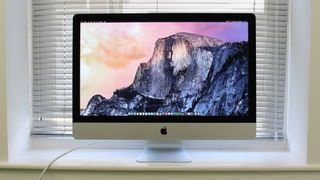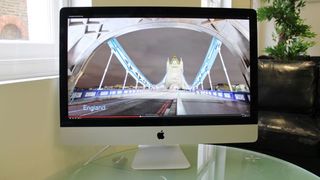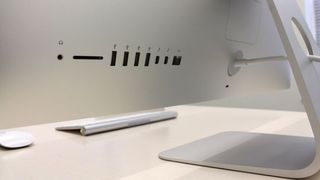Update: Apple has refreshed its 27-inch iMac models with Intel's sixth-generation Skylake processors, upgraded AMD Radeon R9 M395 graphics and displays that boast a wider, multimedia-friendly DCI P3 colour gamut. In T3's tests, the Quad-Core Core i5 CPU in the new top-end iMac came out just 3.8% faster than the fourth-generation Core i5 chip featured in the older 5K iMac reviewed below (as tested with Xbench's CPU benchmark). Graphics were found to be just under 10% faster as measured in Novabench.
Original review follows below...
The iMac with 5K Retina display is easy on the eyes in more ways than one, it's the very first iMac to arrive with an Ultra HD-resolution display.
Using the same screen technology as Apple's Retina iPhones, iPads and MacBooks, the Retina iMac makes everything from text to images look seriously sharp and detailed.
Although the Cupertino company took its time giving the iMac the Retina treatment, in typical Apple fashion, it was a step (or two) ahead of the competition.
MSI's 24GE has a 23.6-inch 4K display but it's geared toward gaming, and Lenovo's ThinkVision 28, which sports a 28-inch 4K display, runs Android. Apple's 5K iMac is a dream machine if you're an OS X fan, but the lack of Windows-powered all-in-ones out there - added to the fact that you can run Windows on the Retina iMac (in Boot Camp) - makes the iMac a tempting option even if you're on Microsoft's side of the fence.

Moreover, the Retina iMac's display goes all the way up to 5K. Its 5,120 x 1,880 pixel-resolution provides extra space on the desktop for browsing the internet, editing 4K videos with the toolbars in full view and undertaking productivity work, gaming and anything else you might beaver away at on a computer.
Of course, you'll have to cough up for the privilege - all that clarity doesn't come cheap, you know. The entry-level iMac starts at £1,599 and comes with a 3.3GHz quad-core Intel Core i5 processor (Turbo Boost to 3.7GHz), 8GB of main memory, AMD Radeon R9 M290 graphics and a 1TB 7200-rpm hard drive.
We tested the high-end version, which is configured with a slightly faster 3.5GHz Core i5 processor (Turbo Boost to 3.9GHz), better AMD Radeon R9 M290X graphics and a nippier 1TB Fusion Drive for £1,849.
Design
Apple slimmed down its 21.5- and 27-inch iMacs back in 2012, and the iMac with 5K Retina Display follows suit. Its components are bundled into the casing behind the display, which features a tapered design measuring 5mm at its thinnest point. The design creates an illusion that makes the iMac look thinner from certain angles, but even at its thickest point it's far from bloated.
The iMac's display panel measures just 1.4mm thin, and Apple had to use a welding process used for glueing together aeroplane wings and tanks to join the front and back parts of its enclosure. Surrounding the display is a black bezel that contrasts with the aluminium finish on the stand and the iMac's chin, which takes care of ventilation.
After you've fed the power and other cables through the cable-tidy hole in the stand, which measures 8 inches deep, all you'll see on the desk is the iMac, your keyboard and mouse. Along with the 12-inch MacBook, it all adds up to a design that represents Apple at its minimalist best and looks fantastic in any room or setting.

Features
The Retina iMac has much more to offer than its display's 14.7 million pixels - including a healthy selection of easily accessible ports around the rear left-hand side. They include a headphone port, SDXC card slot, four USB 3 ports, two speedy Thunderbolt 2 ports packing 20Gbps bandwidth each for hooking up compatible peripherals, and a Gigabit Ethernet port for connecting to a LAN.
There's also built-in Bluetooth 4.0, a 720p FaceTime HD camera that produces clear images, and speakers that are both loud and balanced - though not as bass-driven as dedicated subwoofer systems.
If you're thinking of opting for the entry-level iMac, consider upgrading the standard spinning hard disk drive to a 1TB Fusion Drive for the extra £160, which combines hard disk (for capacity) and flash storage (for quickly accessing your most frequently used apps). It'll be the upgrade that makes the biggest difference in your day-to-day use of the machine.

Performance
The Retina iMac doesn't (yet) feature one of Intel's newer fifth or sixth-generation processors, but the fourth-generation chip inside still packs a punch. Combined with 8GB of RAM, the iMac was able to handle anything I threw at it without a hiccup. If you're the type who browses the internet with 20+ Chrome tabs open while using more than 10 apps and playing a Full HD video in the background, the iMac is capable of handling it.
However, don't expect it to excel at gaming: even the top-spec model's AMD Radeon R9 M290X graphics aren't capable of handling games at 5K, or even 4K - you'll need to lower the resolution to 1440p or even 1080p depending on the game to eke out a higher number of frames.

Usability
The Retina iMac ships with OS X Yosemite, which will be upgradable to OS X El Capitan when it's launched in October. Apple went to some lengths to make Yosemite its most user-friendly operating system yet, integrating iCloud Drive (for cloud storage), introducing a Notification Centre on the right-hand side, adding conversions to Spotlight and making many improvements to its free bundled apps.
They may not be the most feature-packed apps on the Mac, but Pages, Garageband, Numbers, Keynote and Safari are solid and constantly improved offerings - plus you can always raid the App Store for alternatives to find something you might like.
OS X also helps increase the Retina iMac's ease of use by offering several scaled resolutions depending on whether you need more or less space on the desktop to work on. Out of the box, it “looks like” 2,560 x 1440, which provides the same amount of desktop space for working on as Apple's 27-inch non-Retina iMac.
The difference is that anything from fonts to high-resolution images, menus and interfaces are on another planet when it comes to clarity and legibility. Text is easier to read, you can spot the finer details in high-resolution pictures and 4K video comes to life. By adjusting a slider in OS X's settings the resolution can be bumped up to a scaled resolution of 3,200 x 1,800, providing even more desktop space.
I managed to download a third-party app to whack the resolution all the way up to its native 5,120 x 1,880 pixel-resolution, allowing me to edit a 4K movie in Final Cut Pro X with the editing toolbars in full view at 100% zoom.

Verdict
The iMac with 5K Retina display is a stunning computer that's also practical thanks to its pixel-packed display. All of those pixels make a tangible difference to its usability, as not only can you fit more onto the screen, the increased quality makes any task easier on the eyes and a whole lot more enjoyable.
Yes, it's expensive, but there's nothing else quite like it on the market, and if you're thinking of picking up a solidly-built computer with a large display that's jam packed with features and is capable of chewing through any task (except 4K/5K gaming), the Retina iMac is the most stylish and capable all-in-one that you can buy today.


